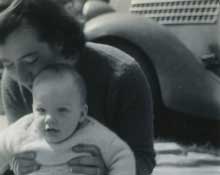When I was an infant, my parents had a 1935 Ford sedan. Since my mother usually drove it, as soon as I began to talk I called it “Mommycar.” My father, on the other hand, drove his Model A Ford roadster, which, because it had been converted with a pickup box in place of the rumble seat, was known as “The Little Truck.” As I remember, the ’35 was a Standard model, with painted radiator shell and a single horn. We don’t have any photos that show the whole car, but it was certainly the “flatback” sedan with external spare, as opposed to a Touring Sedan with built-in trunk. Ford literature showed space for three suitcases behind the rear seat, but even if the cases could truly fit the space was inconvenient and hard to reach. However, we were able to carry two nanny goats and a kid by taking out the rear seat.
Ford’s 1935 cars were designated Model 48, and all were V8-powered. In addition to the two “Fordor” sedans there was a “Tudor” as well as a coupe, a roadster, cabriolet, convertible sedan and phaeton. Designed by Phil Wright at Briggs Manufacturing Company, the Model 48 outsold archrival Chevrolet in the United States, and also became the first Ford V8 assembled in Britain. The British model debuted in February 1935 at Greyfriars Hall in Cardiff, Wales. In France, Fords were manufactured by Matford SA, a joint venture with Emile Mathis.
Our ’35 Ford replaced a Model B Tudor sedan, and served us well for nearly ten years. By the summer of 1948, we were living on a small farm in Connecticut. My father needed a more practical farm vehicle and the Ford was starting to get feeble. That autumn we sold it for $275 and purchased a new Willys CJ-2A Jeep. The Jeep was a compromise vehicle, not quite truck or tractor, and less than a family car. Within a year we had augmented it with a new Mercury, but that’s another story. Every time I see a gray 1935 Ford sedan, I get nostalgic for Mommycar. Perhaps I should buy one.

